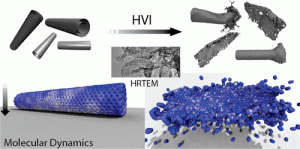1.
Ozden, Sehmus; Autreto, Pedro AS; Tiwary, Chandra Sekhar; Khatiwada, Suman; Machado, Leonardo; Galvao, Douglas S; Vajtai, Robert; Barrera, Enrique V; M. Ajayan, Pulickel
Unzipping Carbon Nanotubes at High Impact Journal Article
Em: Nano letters, vol. 14, não 7, pp. 4131–4137, 2014.
@article{ozden2014unzipping,
title = {Unzipping Carbon Nanotubes at High Impact},
author = {Ozden, Sehmus and Autreto, Pedro AS and Tiwary, Chandra Sekhar and Khatiwada, Suman and Machado, Leonardo and Galvao, Douglas S and Vajtai, Robert and Barrera, Enrique V and M. Ajayan, Pulickel},
url = {http://pubs.acs.org/doi/abs/10.1021/nl501753n},
year = {2014},
date = {2014-01-01},
journal = {Nano letters},
volume = {14},
number = {7},
pages = {4131--4137},
publisher = {American Chemical Society},
abstract = {The way nanostructures behave and mechanically respond to high impact collision is a topic of intrigue. For anisotropic nanostructures, such as carbon nanotubes, this response will be complicated based on the impact geometry. Here we report the result of hypervelocity impact of nanotubes against solid targets and show that impact produces a large number of defects in the nanotubes, as well as rapid atom evaporation, leading to their unzipping along the nanotube axis. Fully atomistic reactive molecular dynamics simulations are used to gain further insights of the pathways and deformation and fracture mechanisms of nanotubes under high energy mechanical impact. Carbon nanotubes have been unzipped into graphene nanoribbons before using chemical treatments but here the instability of nanotubes against defect formation, fracture, and unzipping is revealed purely through mechanical impact.},
keywords = {},
pubstate = {published},
tppubtype = {article}
}
The way nanostructures behave and mechanically respond to high impact collision is a topic of intrigue. For anisotropic nanostructures, such as carbon nanotubes, this response will be complicated based on the impact geometry. Here we report the result of hypervelocity impact of nanotubes against solid targets and show that impact produces a large number of defects in the nanotubes, as well as rapid atom evaporation, leading to their unzipping along the nanotube axis. Fully atomistic reactive molecular dynamics simulations are used to gain further insights of the pathways and deformation and fracture mechanisms of nanotubes under high energy mechanical impact. Carbon nanotubes have been unzipped into graphene nanoribbons before using chemical treatments but here the instability of nanotubes against defect formation, fracture, and unzipping is revealed purely through mechanical impact.
2014
1.

Ozden, Sehmus; Autreto, Pedro AS; Tiwary, Chandra Sekhar; Khatiwada, Suman; Machado, Leonardo; Galvao, Douglas S; Vajtai, Robert; Barrera, Enrique V; M. Ajayan, Pulickel
Unzipping Carbon Nanotubes at High Impact Journal Article
Em: Nano letters, vol. 14, não 7, pp. 4131–4137, 2014.
Resumo | Links | BibTeX | Tags: graphene, unzipping
@article{ozden2014unzipping,
title = {Unzipping Carbon Nanotubes at High Impact},
author = {Ozden, Sehmus and Autreto, Pedro AS and Tiwary, Chandra Sekhar and Khatiwada, Suman and Machado, Leonardo and Galvao, Douglas S and Vajtai, Robert and Barrera, Enrique V and M. Ajayan, Pulickel},
url = {http://pubs.acs.org/doi/abs/10.1021/nl501753n},
year = {2014},
date = {2014-01-01},
journal = {Nano letters},
volume = {14},
number = {7},
pages = {4131--4137},
publisher = {American Chemical Society},
abstract = {The way nanostructures behave and mechanically respond to high impact collision is a topic of intrigue. For anisotropic nanostructures, such as carbon nanotubes, this response will be complicated based on the impact geometry. Here we report the result of hypervelocity impact of nanotubes against solid targets and show that impact produces a large number of defects in the nanotubes, as well as rapid atom evaporation, leading to their unzipping along the nanotube axis. Fully atomistic reactive molecular dynamics simulations are used to gain further insights of the pathways and deformation and fracture mechanisms of nanotubes under high energy mechanical impact. Carbon nanotubes have been unzipped into graphene nanoribbons before using chemical treatments but here the instability of nanotubes against defect formation, fracture, and unzipping is revealed purely through mechanical impact.},
keywords = {graphene, unzipping},
pubstate = {published},
tppubtype = {article}
}
The way nanostructures behave and mechanically respond to high impact collision is a topic of intrigue. For anisotropic nanostructures, such as carbon nanotubes, this response will be complicated based on the impact geometry. Here we report the result of hypervelocity impact of nanotubes against solid targets and show that impact produces a large number of defects in the nanotubes, as well as rapid atom evaporation, leading to their unzipping along the nanotube axis. Fully atomistic reactive molecular dynamics simulations are used to gain further insights of the pathways and deformation and fracture mechanisms of nanotubes under high energy mechanical impact. Carbon nanotubes have been unzipped into graphene nanoribbons before using chemical treatments but here the instability of nanotubes against defect formation, fracture, and unzipping is revealed purely through mechanical impact.


